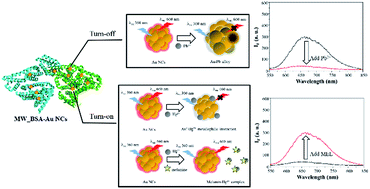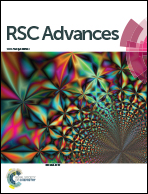Microwave-assisted synthesis of BSA-stabilised gold nanoclusters for the sensitive and selective detection of lead(ii) and melamine in aqueous solution†
Abstract
In this study, a sensitive and selective fluorescence assay using the microwave-assisted synthesis of bovine serum albumin-stabilised gold nanoclusters (MW_BSA-AuNCs) was proposed for the determination of lead(II) and melamine in aqueous solution. The fluorescence of the MW_BSA-AuNCs was quenched through a Pb2+-mediated interparticle aggregation mechanism, and thus the change in fluorescence at 660 nm was dependent on the Pb2+ ion concentration. In addition, the fluorescence of the MW_BSA-AuNCs was also quenched on the basis of the high-affinity metallophilic Hg2+–Au+ interaction, whereas the fluorescence of the MW_BSA-AuNCs was restored when melamine was added and coordinated with Hg2+. Under optimal conditions, the limits of detection for Pb2+ ions and melamine at a signal-to-noise ratio of 3 were 4.8 nM and 2.94 μM, respectively. Our present approach is simpler and more cost-effective than the existing techniques for the detection of Pb2+ ions in seawater and aqueous urine samples and of melamine in milk samples.


 Please wait while we load your content...
Please wait while we load your content...